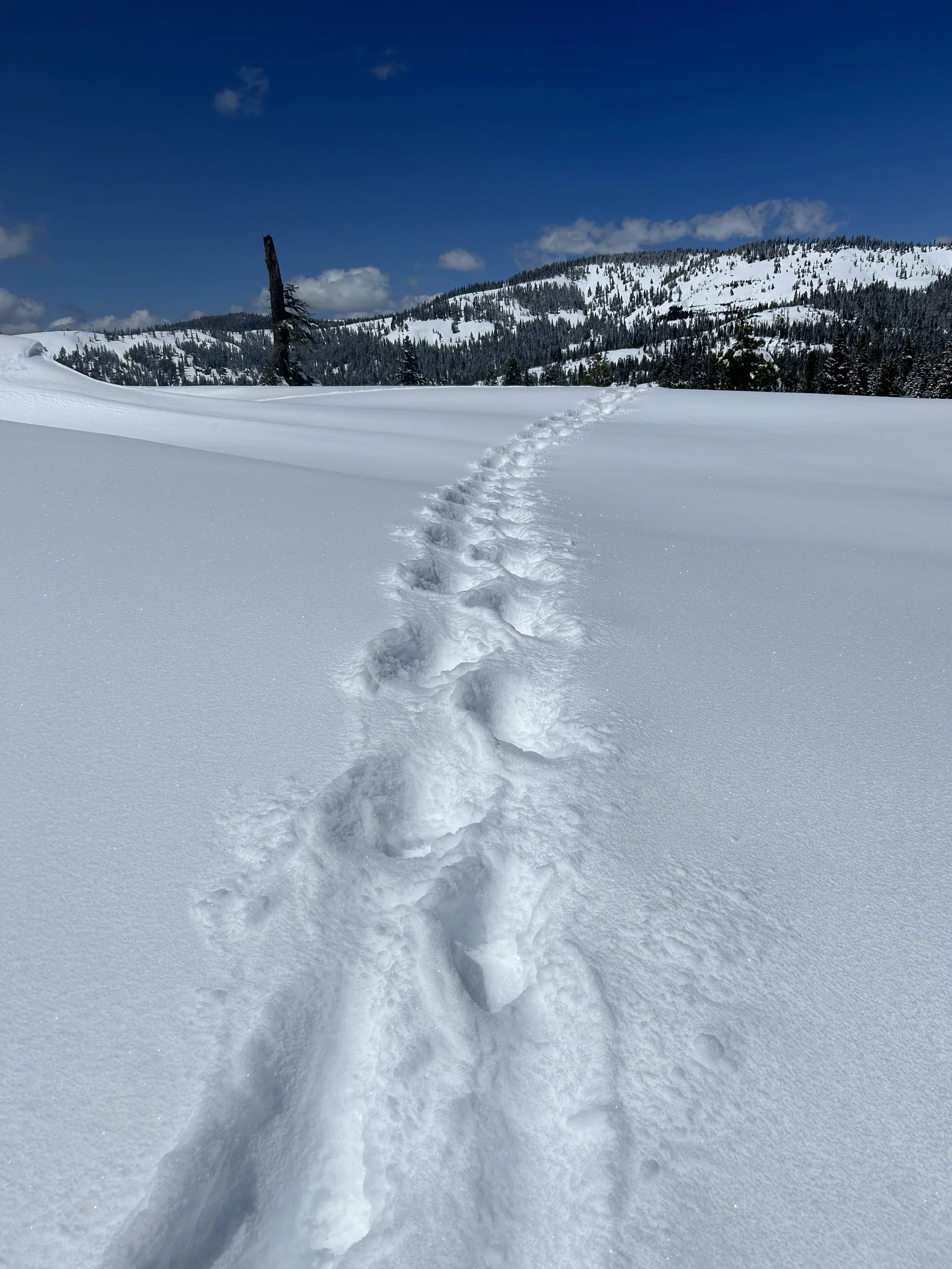The Bears are Back in Town
By: Quinn Rider, BS Ecology, Behavior, & Evolution, BVAC Retail Manager
As the winter season comes to a close in Bear Valley, so too does the denning season of our namesake, the American Black Bear (Ursus americanus), although we were technically named for Grizzly Bears before their extirpation. Visitors and residents of town will have found it impossible to miss their re-emergence as they have raided virtually every dumpster in town.
Figure 1: The first bear tracks on Osborne Ridge from this year, April 7th 2024. Photo Credit: Levi Steinhauer
A study out of Sequoia National Park found that not all bears in the Sierra will hibernate, with around 40% opting out of hibernation entirely (1). This is significantly higher than hibernation rates in Southern California where few black bears undergo hibernation at all. For those bears that did hibernate in the Sierra, hibernation lasted 104 days on average, onsetting around Dec 17th and ending around March 30th. Bears that did not hibernate remained active and mobile all winter (1). This study found little difference between denning habits of bears in natural and urban environments, though more recent research suggests that bears with closer proximity to urban areas hibernate less frequently and for shorter periods due to their continued access to anthropogenic food sources (garbage, fruit trees, etc.) during the winter months when natural food sources are scarce enough to require hibernation (2).
Hibernation itself is an incredibly useful but somewhat costly adaptation. Bears may remain in hibernation for up to 7 months without waking, eating, urinating, or defecating. Their body temperature remains almost normal. However, their pulse drops from their usual 40-50 beats/minute to 8 to 10. Their metabolic rate drops to around 50-70% of that when they’re active. Wild bears emerge from hibernation having lost 16-37% of their body weight and 10-20% of their musculature (3). While these numbers are incredibly small for 7 months of starvation, it does make some sense then that bears with reliable enough access to human food sources to remain healthy throughout the winter might opt out of hibernation.
Figure 2: The first bear tracks on Osborne Ridge from last year, April 4th 2023. Photo Credit: Levi Steinhauer
However, this shortened or skipped hibernation is not without its own costs. Hibernation, despite its drawbacks, slows cellular aging in bears for reasons that have not yet been entirely explained. Urban bears who undergo shorter or no hibernation period cellularly age more quickly than bears in natural environments with normal hibernation patterns. Thus, proximity to urban areas may indirectly shorten lifespan and health in addition to the variety of ways urban environments directly affect bear mortality (vehicular fatalities, management killings, etc. (4).
Indeed, urbanization has drastically altered the ways in which bears in the area forage and behave. A 2006 study out of Yosemite found that proximity to urban areas may be driving a shift from diurnal to nocturnal foraging as bears seek to minimize human interaction while venturing into populated areas in search of food (5). Another study found that 77% of feeding events for bears in urban areas were on anthropogenic sources, the vast majority of which was garbage. In Colorado, that figure increased in years where natural food was sparse and decreased when natural food was abundant. In Tahoe, however, the frequency of anthropogenic feeding remained consistent regardless of natural food availability. Researchers postulated this may have been due to the relatively smaller natural area available to bears for foraging in Tahoe, as the forest is surrounded by desert basins (6).
How then do we discourage bears from consuming garbage? Hazing has proven ineffective as a long-term solution. Only reduction of anthropogenic attractants has proven to be a sustainable strategy to decrease the proportion of human food in bear diets and human-bear conflict. This requires the use of bear-proof receptacles for trash and that they be properly secured (6).
Works Cited
Graber, D. M. (1990). Winter Behavior of Black Bears in the Sierra Nevada, California. Bears: Their Biology and Management, 269. https://doi.org/10.2307/3872928
Johnson, H. E., Lewis, D. L., Verzuh, T. L., Wallace, C. F., Much, R. M., Willmarth, L. K., & Breck, S. W. (2017). Human development and climate affect hibernation in a large carnivore with implications for human–carnivore conflicts. Journal of Applied Ecology, 2, 663–672. https://doi.org/10.1111/1365-2664.13021
Eric, H. (1995). Physiology of Hibernation in Bears. Ursus.
Kirby, R., Johnson, H. E., Alldredge, M. W., & Pauli, J. N. (2019). The cascading effects of human food on hibernation and cellular aging in free-ranging black bears. Scientific Reports, 1. https://doi.org/10.1038/s41598-019-38937-5
Matthews, S. M., Beecham, J. J., Quigley, H., Greenleaf, S. S., & Leithead, H. M. (2006). Activity patterns of American black bears in Yosemite National Park. Ursus, 1, 30–40. https://doi.org/10.2192/1537-6176(2006)17[30:apoabb]2.0.co;2
Lewis, D. L., Baruch-Mordo, S., Wilson, K. R., Breck, S. W., Mao, J. S., & Broderick, J. (2015). Foraging ecology of black bears in urban environments: guidance for human‐bear conflict mitigation. Ecosphere, 8, 1–18. https://doi.org/10.1890/es15-00137.1







